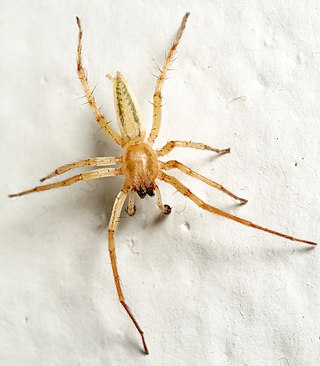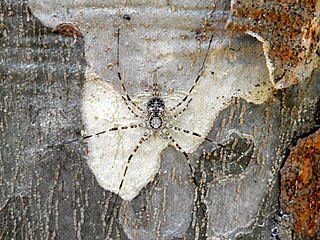
Huntsman spiders, members of the family Sparassidae, catch their prey by hunting rather than in webs. They are also called giant crab spiders because of their size and appearance. Larger species sometimes are referred to as wood spiders, because of their preference for woody places. In southern Africa the genus Palystes are known as rain spiders or lizard-eating spiders. Commonly, they are confused with baboon spiders from the Mygalomorphae infraorder, which are not closely related.

The Pholcidae are a family of araneomorph spiders. The family contains more than 1,800 individual species of pholcids, including those commonly known as cellar spider, daddy long-legs spider, carpenter spider, daddy long-legger, vibrating spider, gyrating spider, long daddy, skull spider, and angel spider. The family, first described by Carl Ludwig Koch in 1850, is divided into 94 genera.

Anyphaenidae is a family of araneomorph spiders, sometimes called anyphaenid sac spiders or ghost spiders. They are distinguished from the sac spiders of the family Clubionidae and other spiders by having the abdominal spiracle placed one third to one half of the way anterior to the spinnerets toward the epigastric furrow on the underside of the abdomen. In most spiders the spiracle is just anterior to the spinnerets.

Velvet spiders are a small group of spiders almost entirely limited to the Old World, with the exception of one species known from Brazil. In Europe, some are commonly called the ladybird spiders.

The rainbow smelt is a North American species of fish of the family Osmeridae. Walleye, trout, and other larger fish prey on these smelt. The rainbow smelt prefer juvenile ciscoes, zooplankton such as calanoid copepods, and other small organisms, but are aggressive and will eat almost any fish they find. They are anadromous spring spawners and prefer clean streams with light flow and light siltation. The rainbow smelt face several barriers. They are weak swimmers and struggle to navigate fish ladders preventing them from making it past dams to the headwater streams where they spawn. The rise in erosion and dams helped to decimate the smelt population in the 1980s. There are currently plans to try to reduce damming and to help control erosion.
Mordacia mordax, known as the short-headed lamprey, Australian lamprey or Murray lamprey, is a species of Mordacia that lives in south-eastern Australia and Tasmania. Mordaciidae is made up of three species: M. praedox, M. mordax, and M. lapicida. M. mordax is a relatively rare, parasitic vertebrate and, along with the hagfishes, is part of the only surviving group of jawless organisms throughout vertebrate evolution. It has a thin eel-like body up to 50 cm (20 in) long, with two low dorsal fins on the back half. The skin is blue-gray or brown. Its eyes are small, and located on the top of its head.

Mordacia praecox, the Australian brook lamprey or nonparasitic lamprey, is a freshwater species of southern topeyed lamprey that occurs in south-eastern Australia. It has a thin eel-like body around 12 to 15 cm long, with two low dorsal fins on the back half. The skin is dark blue above and grey below. Its eyes are small, and located on the top of its head. Unlike M. mordax, M. praecox has eyes that appear to have the potential for dichromatic vision despite being similarly adapted for low-light environments.

Opisthoncus is a genus of South Pacific jumping spiders that was first described by Ludwig Carl Christian Koch in 1880. There are still many Australian species that have not yet been described.

Enoplognatha is a genus of comb-footed spiders first described by P. Pavesi in 1880. They were characterized by both a large colulus and a subspherical abdomen, with males usually have enlarged chelicerae. It is considered a senior synonym of Symopagia.

The California moray is a moray eel of the family Muraenidae, found in the eastern Pacific from just north of Santa Barbara to Santa Maria Bay in Baja California. They are the only species of moray eel found off California, and one of the few examples of a subtropical moray. They typically occupy boulder or cobble habitats up to 40 m in depth. They can attain lengths of about 5 ft (1.52 m) and are believed to live for upwards of 22–26 years. Like other morays, they have no pelvic or pectoral fins or gill covers.

The pungent pipistrelle is a species of vesper bat in the family Vespertilionidae. It is found in Indonesia and possibly the Philippines.

The Talamancan yellow-shouldered bat is a species of bat in the family Phyllostomidae. It is found only in Costa Rica and Panama, and there are no subspecies.

Moggridgea is a genus of spiders in the tree dwelling family, Migidae. The genus was first described by Octavius Pickard-Cambridge in 1875, who named the genus after naturalist John Traherne Moggridge.

An anchovy is a small, common forage fish of the family Engraulidae. Most species are found in marine waters, but several will enter brackish water, and some in South America are restricted to fresh water.

Alireza Zamani is an Iranian arachnologist and taxonomist.
Lupettiana is a genus of anyphaenid sac spiders first described by Antônio Brescovit in 1997.

Neotama mexicana, also known as the long-spinneret spider or Mexican two-tailed spider, is a species of tree trunk spider in the family Hersiliidae. It is found in a range from the United States to Peru and Guyana.

Habronattus tranquillus is a species of jumping spider in the family Salticidae. It is found in the United States and Mexico.

Uroctonus mordax, known generally as the California forest scorpion or western forest scorpion, is a species of scorpion in the family Vaejovidae. Most notably, this species is almost entirely restricted to California's Redwood Forests and Oak Woodlands, and is considered a foundational species in those ecosystems. They are most often found on south or west-facing slopes, under rocks or logs on the ground, and prefer a moist environment.
Geophilus mordax, also called the pitted soil centipede, is a species of soil centipede in the family Geophilidae found in North America, especially Indiana, Arkansas, Louisiana, North and South Carolina, and Florida. It grows up to 50 millimeters in length, though it averages 25–40, has 49–53 leg pairs in males and 49–57 in females, and is bright red in color. G. mordax also bears 3–5 labral teeth, a short and robust apical claw of the second maxillae, an exposed prebasal plate, and a large, consolidated sacculi.

















